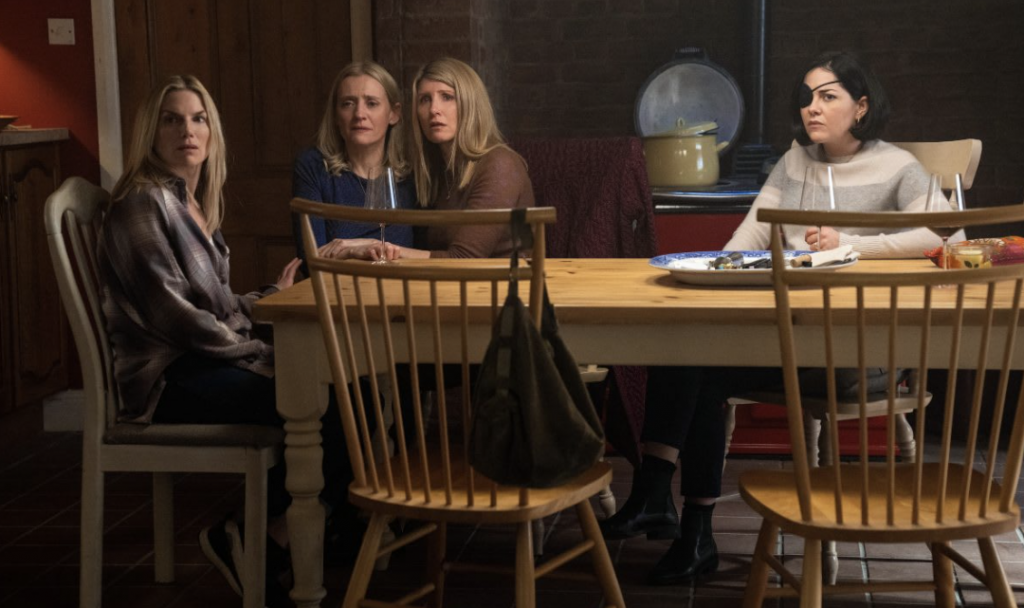Looking Back on Bad Sisters– A Spoiler-Free Review

Kaitlyn Hardy ’25 / Emertainment Monthly Staff Writer
Nonlinear whodunnits are no new, groundbreaking thing, but crafting a suspenseful buildup without revealing too much, following a large group of characters while still making each one distinctive, and balancing time jumps without causing confusion is a fine line to walk on. Bad Sisters, however, checks all of these boxes. The show is seat-clenchingly suspenseful, cynically humorous, and wonderfully satirical—the perfect concoction for your next binge watch.
The 10 episode show, created and produced by (and starring) Sharon Horgan, is an adaptation of the Flemish series, Clan.
The show released on Apple TV back in mid August, but earned recent acclaim. In December, the show was nominated for the Critics’ Choice Television Award for Best Drama Series and Sharon Horgan earned a nomination for the Critics’ Choice Television Award for Best Actress in a Drama Series. In January, the show earned more nominations from the Writers Guild of America in the Best New Series and Best Episodic Drama categories.
Bad Sisters follows five sisters—Becka (Eve Hewson), Bibi (Sarah Greene), Eva (Sharon Horgan), Grace (Anne-Marie Duff), and Ursula (Eva Birthistle). Four of the sisters—Becka, Bibi, Eva, and Ursula—repeatedly attempt to murder Grace’s husband, John “JP” Paul (Claes Bang), a truly terrible man whose actions are nothing short of evil. The mystery of the sisters’ continuously unlucky murder efforts is heightened by the show’s second plot, where two insurance agents—Matthew (Daryl McCormack) and Thomas (Brian Gleeson)—investigate the intentions behind JP’s death, cornering the sisters at any chance they get.

The show portrays the time jumps between these two plots, pre and post JP’s death, in a simple yet stylistic way. Scenes are shown as negatives in a roll of film, the frames moving back and forth with time. However straightforward this method may be, it’s not at all to the show’s detriment. As the show takes place in the span of several months to a year, the characters are not noticeably different between the two time frames, so a very obvious change in time would be the only way to depict a time jump. Plot wise, the two mysteries swell in tandem with each other, reaching their heights and resolutions in satisfying synchronicity.
The excellence of Bad Sisters lies in its characters. Although the murder-mystery plot is shocking, humorous, and undoubtedly entertaining, the writing of these characters is what pulls this mystery, and therefore, the entire show through.
Each character is distinctive, and although this may mean the characters are pigeonholed into personality types, the show still manages to balance these personalities with depth and eventual surprise. Eva is strong and stubborn; Bibi, angry and withheld; Becka, wild and immature; Grace, frail and mousy. Perhaps the best written character is the worst one of the show: John Paul, a consistently abhorrent person whose depths of cruelty descend farther and farther below viewers’ expectations, while still staying within the realms of the show and reality.
The bond between the show’s characters is crafted extremely well. The deep care each sister has for one another is never doubted and heightens the stakes of the entire show. Their unbreakable love and concern for each other adds the edge of emotion the show calls for in its mass of darkness.

What’s more, the acting of each and every character is extremely well-done. Anne-Marie Duff, who plays Grace, devastatingly captures the hopelessness of a character who is constantly beat down. She delivers pure emotion, especially in the show’s finale. And Claes Bang exquisitely delivers the gaslighting, wicked passive-aggressiveness of the wholly unredeemable JP.
The finale’s reveal is somewhat of a twist, and as darkly cathartic for the characters as it is for the audience, slightly undercuts one of the show’s main conflicts. Nevertheless, Bad Sisters’ resolution was still satisfying, and everything leading up to it filled with deep emotion, sardonic quips, and suspense that begged for one episode to be bled into the next.